


Iodine chloride - an interhalogen compound
This experiment shows an example of the formation of interhalogen compounds. The halogens react with each other easily and form binary compounds with properties which are somewhat between the properties of the parent halogens.
![]()
![]() This
experiment uses chlorine gas extensively. It should be conducted in a good fume
hood or outside. Do not attempt to do this in a poorly ventilated room!
This
experiment uses chlorine gas extensively. It should be conducted in a good fume
hood or outside. Do not attempt to do this in a poorly ventilated room!
On this page, two separate experiments are described. First, the formation of two different iodine chlorides is shown, second the reaction with metallic magnesium of the interhalogen compound is shown.
![]()
![]() Required
chemicals:
Required
chemicals:
-
iodine
-
hydrochloric acid
-
bleach or calcium hypochlorite
-
magnesium turnings, only needed for experiment 2
- sodium sulfite (for safe disposal)
![]() Required
equipment:
Required
equipment:
-
test tube
- little bottle
- heater for test tube
- syringe + small plastic tube
![]() Safety:
Safety:
- iodine is quite toxic and corrosive. It stains everything with which it is brought in contact;
- hydrochloric acid is corrosive, the concentrated acid emits corrosive and very pungent fumes;
- bleach is corrosive and emits toxic chlorine gas when acidified;
- calcium hypochlorite is corrosive and emits toxic chlorine gas when acidified;
- the reaction with magnesium is fairly voilent and quite some heat is evolved;
-
 chlorine gas is
very toxic and has an exceedingly pungent smell. This gas is generated
in a glass bottle and manipulated with a syringe. Be careful not to breathe
any chlorine gas.
chlorine gas is
very toxic and has an exceedingly pungent smell. This gas is generated
in a glass bottle and manipulated with a syringe. Be careful not to breathe
any chlorine gas. -
 the iodine
chloride, formed in this experiment, is very corrosive and one must
be really careful not to get any of this liquid on the skin.
the iodine
chloride, formed in this experiment, is very corrosive and one must
be really careful not to get any of this liquid on the skin.
![]() Disposal:
Disposal:
- Any excess chlorine gas, not used in this experiment can be released in the air, outside or in a good fume hood. The bleach or calcium hypochlorite solution can be flushed down the drain with a lot of water. Any left over iodine or iodine chloride waste must be neutralized with a solution of sodium sulfite. The neutralized solution can be flushed down the drain with a lot of water. Any left over magnesium metal can be destroyed with some dilute hydrochloric acid. The solution can be flushed down the drain with a lot of water.
- Do not flush elemental iodine or magnesium down the drain. These must be neutralized/destroyed as described above. Also collecting solid iodine waste and putting this in the waste bin is not a very wise idea.
![]()
Preparation of chlorine and the syringe
![]() Approximately 50 ml of chlorine gas is needed in this
experiment. The gas need not be very pure, when it still contains some air, then
that is not a real concern. The chlorine gas can best be prepared by adding
approximately 500 mg of calcium hypochlorite to approximately 5 ml of dilute
hydrochloric acid (appr. 10% HCl by weight). This must be done in a bottle of
100 ml. An alternative may be to use 10 ml of chlorine household bleach
(containing 4 or 5% so-called active chlorine) and adding concentrated
hydrochloric acid to this. When the chlorine is prepared, then the bottle must
be capped. The water does not need to be removed.
Approximately 50 ml of chlorine gas is needed in this
experiment. The gas need not be very pure, when it still contains some air, then
that is not a real concern. The chlorine gas can best be prepared by adding
approximately 500 mg of calcium hypochlorite to approximately 5 ml of dilute
hydrochloric acid (appr. 10% HCl by weight). This must be done in a bottle of
100 ml. An alternative may be to use 10 ml of chlorine household bleach
(containing 4 or 5% so-called active chlorine) and adding concentrated
hydrochloric acid to this. When the chlorine is prepared, then the bottle must
be capped. The water does not need to be removed.
![]() Prepare a syringe, by attaching a small plastic flexible tube
to it. It is best to use a 20 ml syringe.
Prepare a syringe, by attaching a small plastic flexible tube
to it. It is best to use a 20 ml syringe.
The two pictures below show the setup, used for the chlorine.
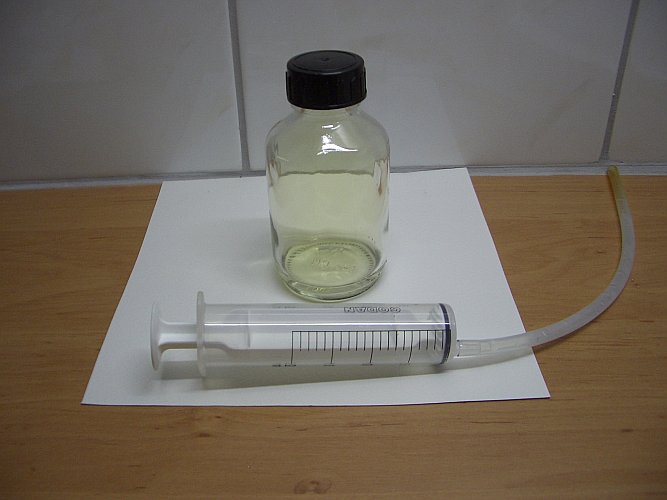
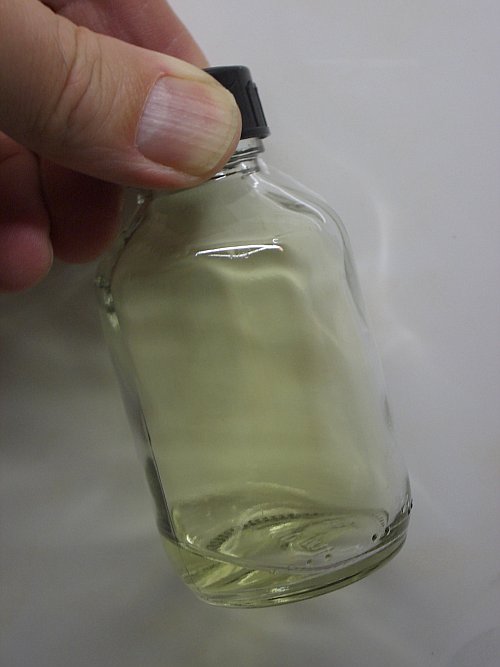
Reaction of iodine with a small amount of chlorine
![]() Take a
spatula of iodine and put this in a test tube.
Take a
spatula of iodine and put this in a test tube.
![]() Take the syringe with the flexible plastic tube and immerse
the open end of the tube in the chlorine gas, just above the water layer. Be
sure not to touch the water layer, there should be no liquid water in the
syringe or the plastic tube. Now suck in 20 ml of chlorine gas. After this,
immediately cap the bottle again.
Take the syringe with the flexible plastic tube and immerse
the open end of the tube in the chlorine gas, just above the water layer. Be
sure not to touch the water layer, there should be no liquid water in the
syringe or the plastic tube. Now suck in 20 ml of chlorine gas. After this,
immediately cap the bottle again.
![]() Now, put the open end of the plastic flexible tube in the
test tube, containing the iodine. Keep it just above the iodine, without
touching that. Now, slowly press approximately 5 ml of chlorine gas in
the test tube.
Now, put the open end of the plastic flexible tube in the
test tube, containing the iodine. Keep it just above the iodine, without
touching that. Now, slowly press approximately 5 ml of chlorine gas in
the test tube.
The two pictures below show some iodine and the result of slowly adding 5 ml of chlorine gas. The iodine has wetted somewhat and the color has changed to deep red instead of metallic/grey. There also is some brown vapor.
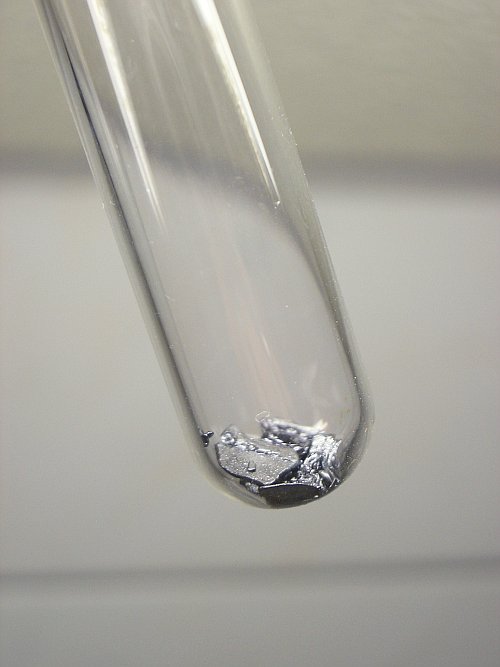
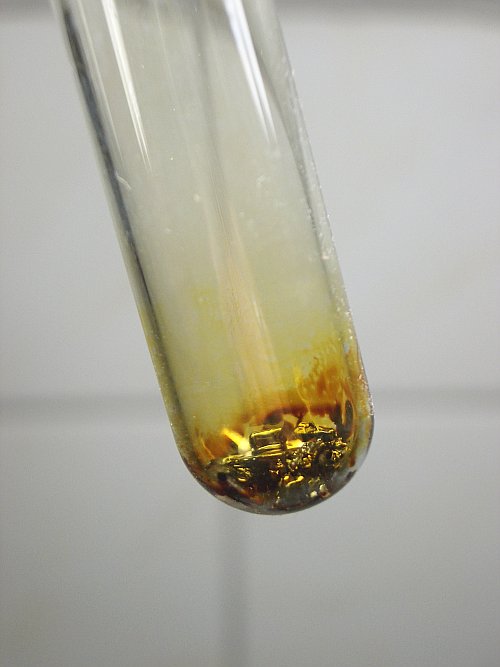
![]() Now
slowly press the remaining 15 ml of chlorine gas from the syringe, with the open
end of the flexible plastic tube again just above the iodine.
Now
slowly press the remaining 15 ml of chlorine gas from the syringe, with the open
end of the flexible plastic tube again just above the iodine.
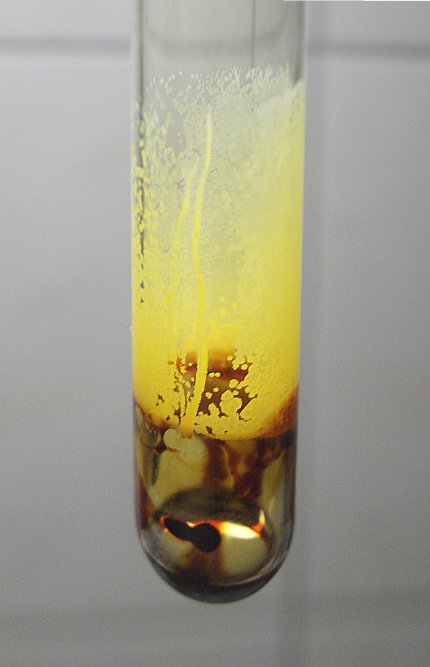
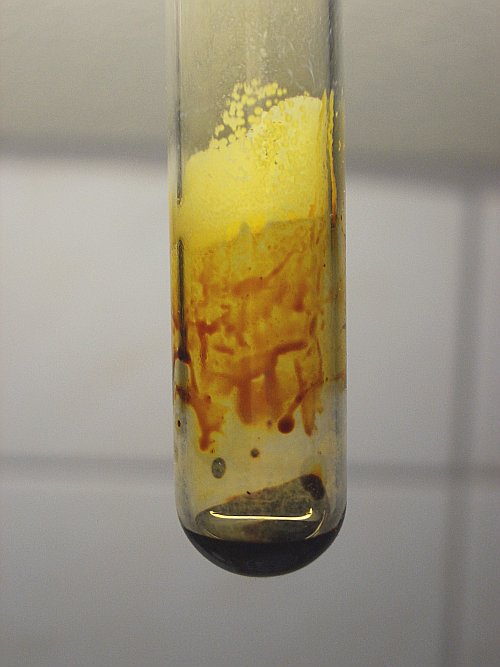
What now can be seen is that all iodine has become liquid. An almost black liquid is formed with a somewhat metallic lustre. A yellow/brown vapor is formed and a deep red liquid, which sticks to the glass. Higher up in the test tube, a yellow solid is formed. This yellow solid is very heat-sensitive. With the heat of a hand, applied at the test tube, it simply disappears and changes into a dark red liquid. The left picture shows the result of adding the other 15 ml of chlorine, the right picture shows the same test tube with a little careful swirling and in the meantime holding it in the hand, such that it is heated a little bit. Almost all yellow solid has changed into the red/brown liquid. When the test tube is kept in a warm hand for one minute, then all of the yellow solid has disappeared, as is shown nicely in the picture below. Besides that, the almost black liquid turns a little lighter and looses some of its metallic lustre. It also seems to wet the glass more extensively.
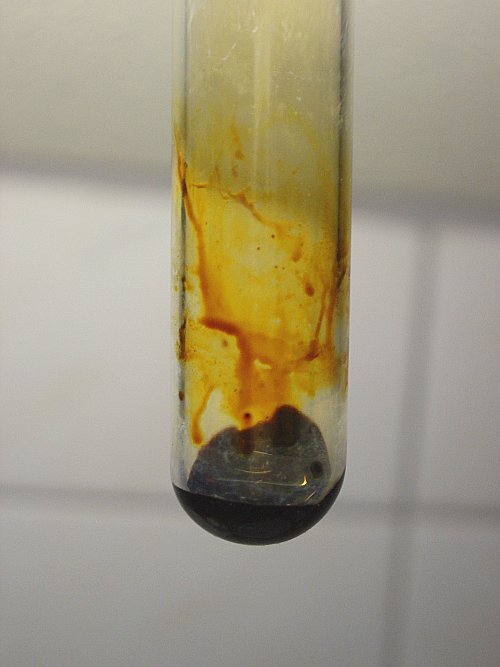
Volatility of the compound
![]() Now, another two syringes of chlorine/air mix are taken from
the bottle and are pushed into the test tube very slowly and so, more chlorine
is entered into the mixture. Again, a yellow compound is formed, which
disappears again on slight heating. Now, the liquid becomes very volatile and dark red/brown. The liquid,
sticking to the glass slowly moves downwards along the glass and it does not
leave a residue. It wets the glass, but while the liquid moves downwards, it
seems to disappear and the glass becomes dry. Small droplets of the liquid also become smaller quickly.
The left picture below shows the test tube after some swirling, the right
picture shows the same test tube a little later.
Now, another two syringes of chlorine/air mix are taken from
the bottle and are pushed into the test tube very slowly and so, more chlorine
is entered into the mixture. Again, a yellow compound is formed, which
disappears again on slight heating. Now, the liquid becomes very volatile and dark red/brown. The liquid,
sticking to the glass slowly moves downwards along the glass and it does not
leave a residue. It wets the glass, but while the liquid moves downwards, it
seems to disappear and the glass becomes dry. Small droplets of the liquid also become smaller quickly.
The left picture below shows the test tube after some swirling, the right
picture shows the same test tube a little later.
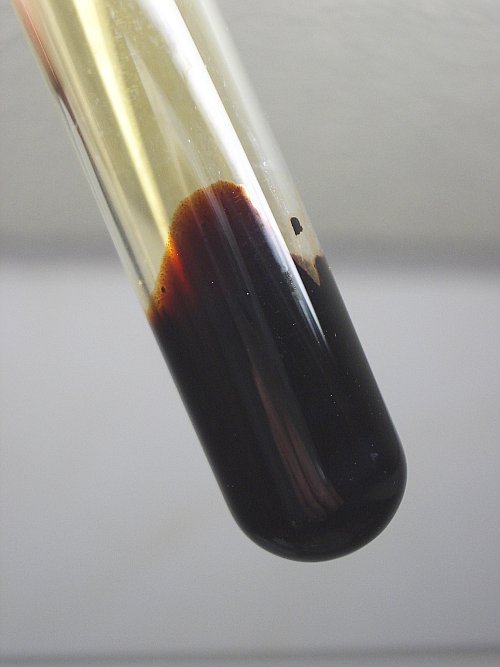
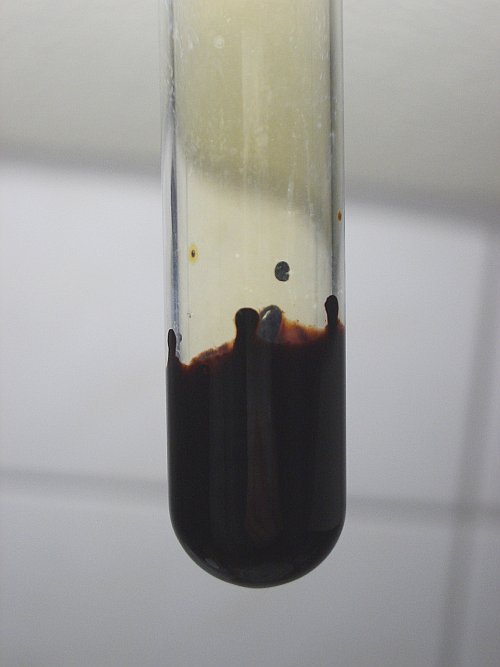
![]() When the test tube with the dark brown/red liquid is heated,
then it starts boiling quickly and a thick brown fume is formed. Beautiful
patterns are formed on the glass of the test tube and the yellow compound is
formed again. The picture below shows the result of heating for just a few
seconds.
When the test tube with the dark brown/red liquid is heated,
then it starts boiling quickly and a thick brown fume is formed. Beautiful
patterns are formed on the glass of the test tube and the yellow compound is
formed again. The picture below shows the result of heating for just a few
seconds.
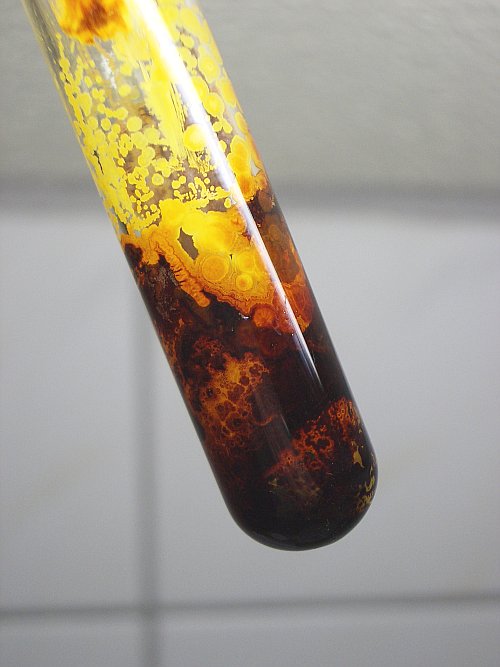
![]() When the liquid is heated for a longer time and more
strongly, then the liquid starts boiling and splashing violently in the test
tube and a dark brown fume is formed. The yellow compound now is formed higher
up in the test tube, but hardly any gas or fume leaves the test tube. The
material condenses on the inside of the test tube in the higher (and cool) part
of the test tube. The two pictures below show the hot test tube and the cooled
down test tube. In the cooled down test tube, one can see that most of the
yellow compound already has disappeared again.
When the liquid is heated for a longer time and more
strongly, then the liquid starts boiling and splashing violently in the test
tube and a dark brown fume is formed. The yellow compound now is formed higher
up in the test tube, but hardly any gas or fume leaves the test tube. The
material condenses on the inside of the test tube in the higher (and cool) part
of the test tube. The two pictures below show the hot test tube and the cooled
down test tube. In the cooled down test tube, one can see that most of the
yellow compound already has disappeared again.
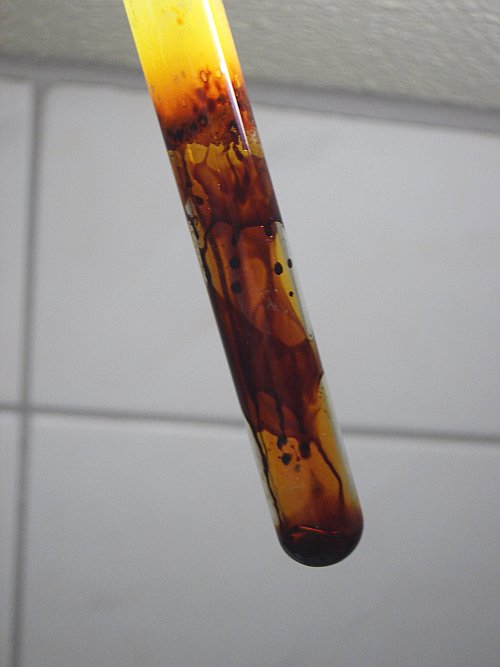
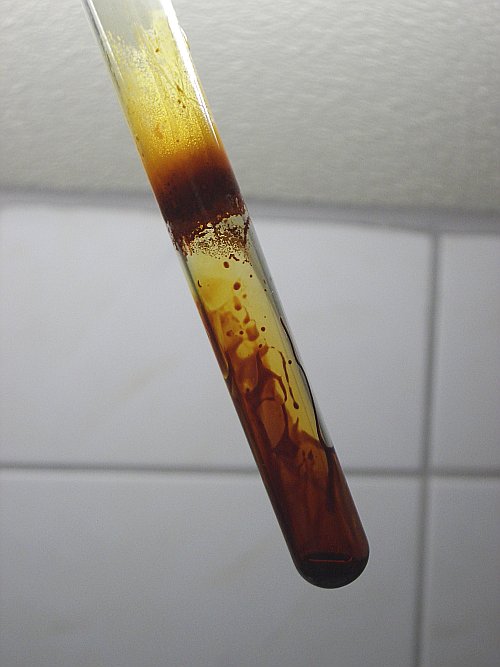
The most remarkable is that after cooling down and keeping the test tube in a warm hand, finally all material goes downwards and the glass becomes clean again, with just a layer of dark brown/red liquid at the bottom, with a yellow/brown vapor above it. This can nicely be seen in the picture, taken at the start of the second experiment with magnesium added to the iodine/chlorine compound.
![]()
Second experiment: reaction with magnesium
![]() The heated test tube was allowed to cool down and all liquid
finally disappeared from the glass and there only was some liquid at the bottom
of the test tube. To this liquid, a shaving of magnesium metal was added (about
the size of a hollow pea). The picture below shows the iodine chloride, in a
clean test tube, with brown vapor above it and the piece of magnesium, floating
on the surface of the liquid. There was no reaction at all and even making the
liquid warm with a hand did not result in any reaction.
The heated test tube was allowed to cool down and all liquid
finally disappeared from the glass and there only was some liquid at the bottom
of the test tube. To this liquid, a shaving of magnesium metal was added (about
the size of a hollow pea). The picture below shows the iodine chloride, in a
clean test tube, with brown vapor above it and the piece of magnesium, floating
on the surface of the liquid. There was no reaction at all and even making the
liquid warm with a hand did not result in any reaction.
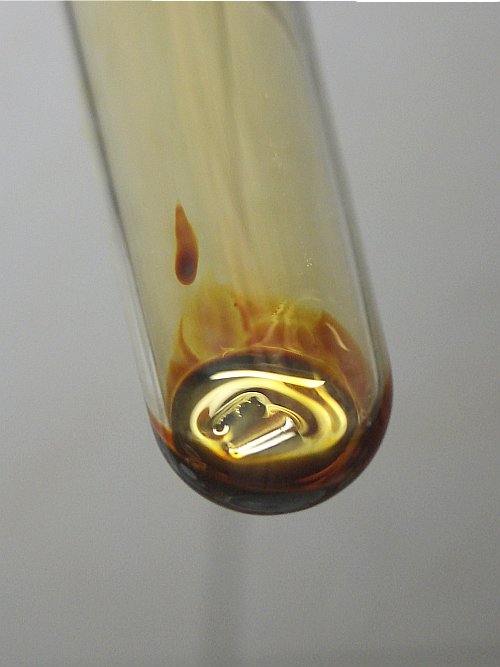
![]() Next, a single large drop of water was allowed to enter the
mix, with the piece of magnesium in it.
Next, a single large drop of water was allowed to enter the
mix, with the piece of magnesium in it. ![]() This results in a very violent reaction, which starts at once. A lot of deep
red/purple fume is produced and a lot of heat is produced. No signs of fire,
however can be observed. The dark liquid starts boiling violently.
This results in a very violent reaction, which starts at once. A lot of deep
red/purple fume is produced and a lot of heat is produced. No signs of fire,
however can be observed. The dark liquid starts boiling violently.
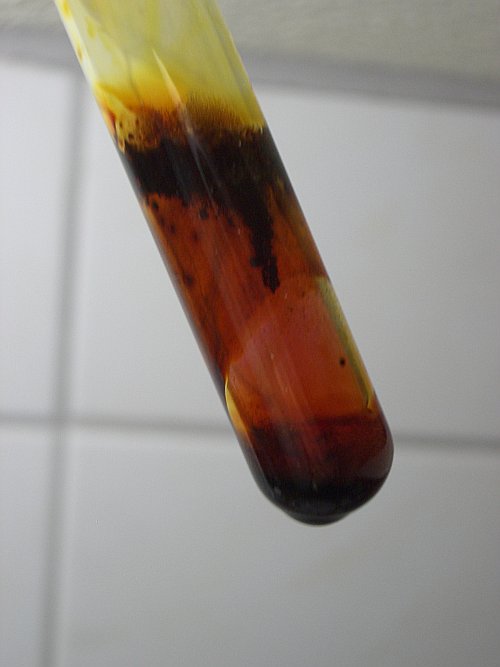
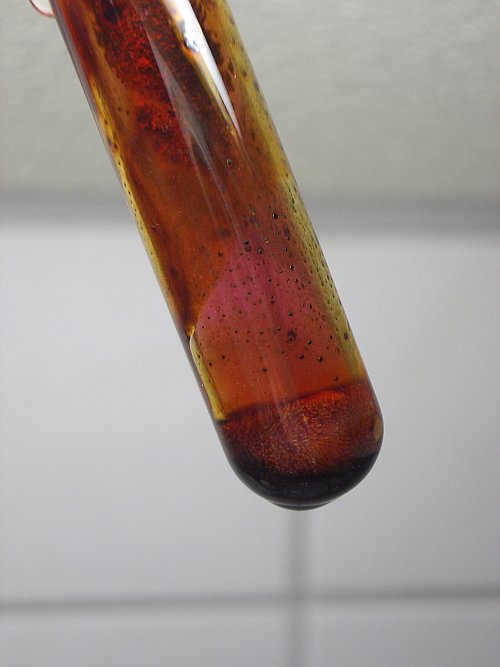
When the reaction is allowed to run for a while, then gold-yellow/brown crystals are formed at the glass, somewhat higher up in the test tube. The purple/red color of the fumes most likely is due to formation of gaseous iodine, mixed with the brown vapor of iodine chloride.
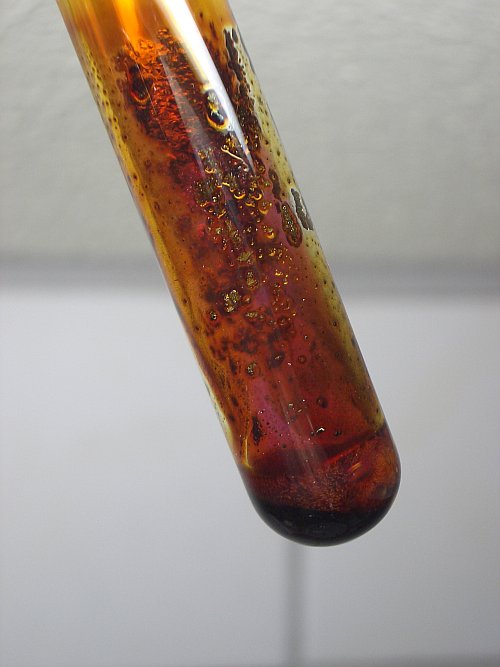
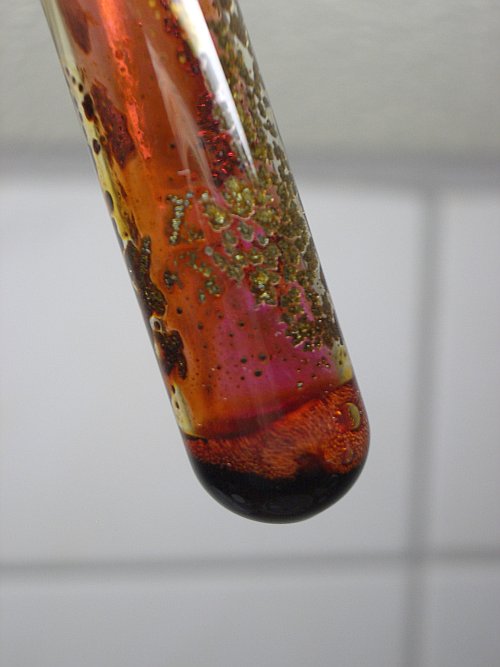
The crystals, formed at the glass wall of the test tube get a really beautiful appearance. They really look as if they are made of a metal with a gold like lustre. Below, the test tube is shown, when the reaction has stopped almost. A deep purple vapor exists just above the liquid, beautiful crystals are sticking to the glass. At the right, a close-up is made of the crystals. The largest crystals have a size of approximately 1.5 mm.
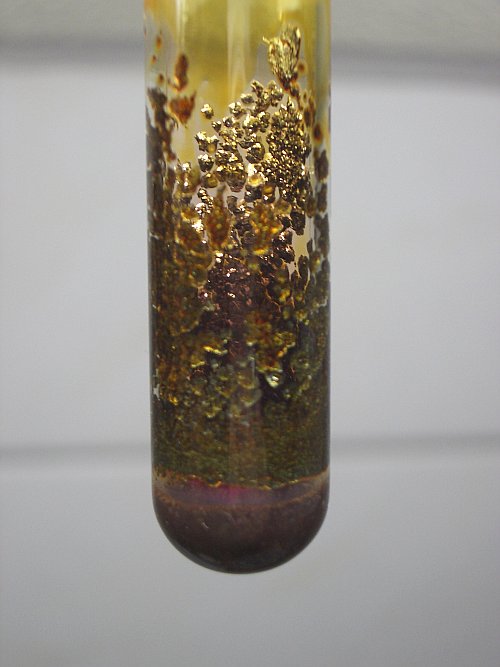
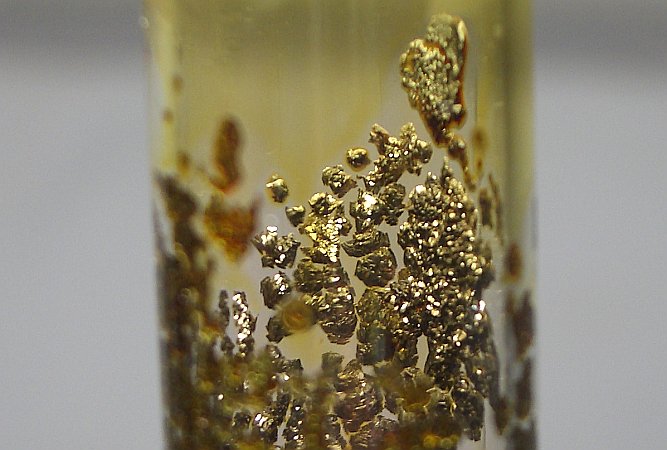
![]() When the reaction ceased, a lot more water was added. The
crystalline mass in the test tube at the glass walls changed to a grey
precipitate with a metallic lustre, the liquid at the bottom solidified at once
to a dark-grey mass. A clear brown/yellow liquid was formed. This brown/yellow
color is due to the color of iodine, dissolved in water.
When the reaction ceased, a lot more water was added. The
crystalline mass in the test tube at the glass walls changed to a grey
precipitate with a metallic lustre, the liquid at the bottom solidified at once
to a dark-grey mass. A clear brown/yellow liquid was formed. This brown/yellow
color is due to the color of iodine, dissolved in water.
When the water was decanted and the crystals on the glass washed another time with water, then they appeared to be simply iodine. This is shown by the pictures below. They show crystalline iodine, which looks grey with a metallic lustre. The remarkable yellow color, covering the crystals has disappeared.
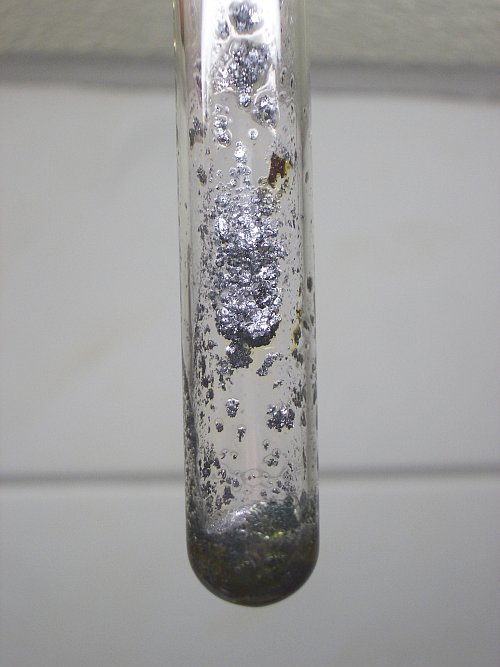
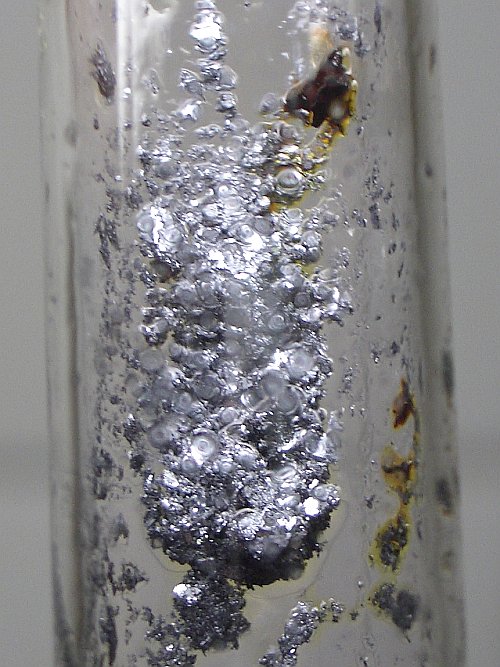
When a solution of sodium sulfite is added to the test tube, then the grey/metal-like solid mass quickly dissolves, the solid at the bottom of the test tube also dissolves, but that takes considerably more time.
![]()
Discussion of results
![]() Iodine reacts with chlorine to form iodine (I) chloride. This
is a fairly stable compound. With excess chlorine the very unstable yellow
compound iodine (III) chloride is formed in an equilibrium.
Iodine reacts with chlorine to form iodine (I) chloride. This
is a fairly stable compound. With excess chlorine the very unstable yellow
compound iodine (III) chloride is formed in an equilibrium.
When chlorine and iodine are mixed in stoichiometric amounts, then the following reaction occurs:
I2 + Cl2 → 2ICl
The compound ICl is a red/brown volatile liquid at room temperature, which very much resembles bromine in appearance. This compound has a brown/yellow vapor. When it is heated it partly decomposes back to iodine and chlorine. At 100 °C approximately 1% of the ICl decomposes to chlorine and iodine again, when kept in a confined space.
![]() With excess chlorine, the following equilibrium reaction
occurs:
With excess chlorine, the following equilibrium reaction
occurs:
ICl + Cl2 ↔ ICl3
Only in the presence of a lot of excess chlorine, macroscopic quantities of this yellow solid are formed. When the chlorine is taken away, then the solid quickly decomposes, forming ICl and Cl2. The compound ICl3 is a bright yellow compound, which has a melting point of 101 °C, but at that temperature it already requires a pressure of 16 atmosphere of chlorine gas, otherwise it will decompose to ICl and Cl2. At normal pressure, the compound ICl3 quickly decomposes when it is not kept in an atmosphere of chlorine. This also explains, why this compound first is formed, when chlorine is pressed into the test tube from the syringe, while at a later time it disappears again.
![]() When
magnesium metal is added to the liquid ICl, then it does not react, when it is
dry. This is similar to the phenomenon, that a dry mix of magnesium powder and
iodine does not react. As soon as a small amount of water is added, then a
violent reaction occurs. This reaction can be described as follows:
When
magnesium metal is added to the liquid ICl, then it does not react, when it is
dry. This is similar to the phenomenon, that a dry mix of magnesium powder and
iodine does not react. As soon as a small amount of water is added, then a
violent reaction occurs. This reaction can be described as follows:
Mg + 2ICl → MgCl2 + I2
The iodine is released as a purple vapor at the high temperatures at which the reaction occurs.
Probably the following reaction also occurs:
Mg + I2 → MgI2
![]() The beautiful gold color of the crystals, formed at the walls
of the glass tube, is a mystery to me. It might be that these are due to a thin
layer of some iodine/chlorine mix or some iodine/chlorine compound. As soon as
the crystals are made wet with water, the mysterious golden color disappears and
they get the well-known grey/metallic color of elemental iodine.
The beautiful gold color of the crystals, formed at the walls
of the glass tube, is a mystery to me. It might be that these are due to a thin
layer of some iodine/chlorine mix or some iodine/chlorine compound. As soon as
the crystals are made wet with water, the mysterious golden color disappears and
they get the well-known grey/metallic color of elemental iodine.
The gold color may also be due to the fact that the crystals of iodine are covered by a very thin layer of ICl, which may look yellow, when the layer is very thin.